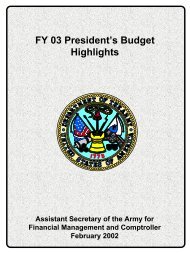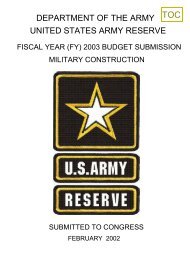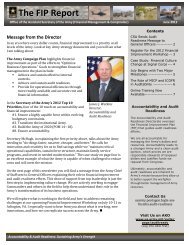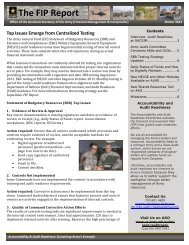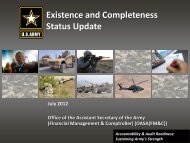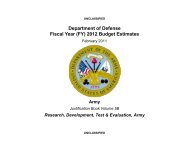Army Audit Readiness Strategy FY 2013 - Army Financial ...
Army Audit Readiness Strategy FY 2013 - Army Financial ...
Army Audit Readiness Strategy FY 2013 - Army Financial ...
Create successful ePaper yourself
Turn your PDF publications into a flip-book with our unique Google optimized e-Paper software.
<strong>FY</strong> <strong>2013</strong> <strong>Army</strong> <strong>Audit</strong> <strong>Readiness</strong> <strong>Strategy</strong><br />
2.0 Overview<br />
The <strong>Army</strong> is transforming the way it does business. In the last three years, the <strong>Army</strong> has<br />
experienced unprecedented changes in its business operations. More changes are coming as the<br />
<strong>Army</strong> works toward standardizing its business practices and improving internal controls. The<br />
result will be an <strong>Army</strong> that can produce timely, relevant, and accurate business and financial<br />
information that supports the highest standards of military readiness.<br />
Congress requires the Department of<br />
Defense (DoD) to have audit ready<br />
financial statements by 2017. Secretary of<br />
Defense Leon E. Panetta assured Congress<br />
that all of the Services will have auditable<br />
Statements of Budgetary Resources (SBR)<br />
by 2014 and will achieve audit readiness<br />
for all financial statements by 2017.<br />
<strong>Army</strong> leadership is committed to these<br />
audit readiness goals. They have<br />
communicated that improved financial<br />
operations and strengthened fiscal<br />
stewardship are now top priorities<br />
throughout the <strong>Army</strong> in strategic<br />
documents such as the Secretary’s Top<br />
Priorities list and the <strong>Army</strong> Campaign<br />
Plan.<br />
“Responsible<br />
stewardship of<br />
taxpayer resources<br />
and operating<br />
business processes<br />
within an effective<br />
control<br />
environment are<br />
consistent with<br />
high standards of military readiness ...”<br />
—Chief of Staff of the <strong>Army</strong><br />
General Raymond T. Odierno in a message to<br />
General Officers on April 2012.<br />
2.1 Background<br />
Over the years, Congress has enacted legislation to define and shape the federal financial<br />
management landscape. These laws have initiated and guided <strong>Army</strong> financial improvement<br />
efforts. The most frequently referenced legislation and requirements are described in the table<br />
below.<br />
Federal Managers’<br />
<strong>Financial</strong> Integrity Act<br />
(FMFIA) of 1982<br />
Chief <strong>Financial</strong> Officers<br />
(CFO) Act of 1990<br />
Government Performance<br />
and Results Act (GPRA)<br />
of 1993<br />
Government Management<br />
Reform Act (GMRA) of<br />
1994<br />
Table 1: <strong>Financial</strong> Legislation and Requirements<br />
Authorizes GAO to prescribe standards of internal control. It also requires<br />
agency heads to establish a system of internal controls, annually evaluate<br />
the effectiveness of those controls, report identified weaknesses, and<br />
implement corrective action plans.<br />
Requires federal agencies to annually prepare auditable financial<br />
statements.<br />
Requires agencies to report on and measure progress towards established<br />
goals, including financial management goals.<br />
Extended the requirements of the CFO Act to include agency-wide reports<br />
from all major executive branch agencies and their components and for the<br />
government as a whole.<br />
Accountability & <strong>Audit</strong> <strong>Readiness</strong>: Sustaining <strong>Army</strong>’s Strength 1



